
A brick is a type of block used to build walls, pavements and other elements in masonry construction. Properly, the term brick denotes a block composed of dried clay, but is now also used informally to denote other chemically cured construction blocks. Bricks can be joined using mortar, adhesives or by interlocking them. Bricks are produced in numerous classes, types, materials, and sizes which vary with region and time period, and are produced in bulk quantities.

Government House, commonly referred to as Yarralumla, is the official residence of the governor-general of Australia. It is located in the suburb of Yarralumla, in the City of Canberra, in the Australian Capital Territory. The house is set amid 54 hectares of parkland. The house and associated grounds were added to the Commonwealth Heritage List on 22 June 2004.
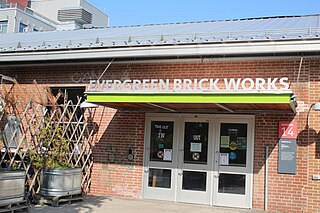
The Don Valley Brick Works is a former quarry and industrial site located in the Don River Valley in Toronto, Ontario, Canada. The Don Valley Brick Works operated for nearly 100 years and provided bricks used to construct many well-known Toronto landmarks, such as Casa Loma, Osgoode Hall, Massey Hall, and the Ontario Legislature. Since the closure of the original factory, the quarry has been converted into a city park which includes a series of naturalized ponds, while the buildings have been restored and opened as an environmentally focused community and cultural centre by Evergreen, a national charity dedicated to restoring nature in urban environments.

An oast, oast house or hop kiln is a building designed for kilning (drying) hops as part of the brewing process. They can be found in most hop-growing areas and are often good examples of vernacular architecture. Many redundant oasts have been converted into houses. The names oast and oast house are used interchangeably in Kent and Sussex. In Surrey, Hampshire, Herefordshire and Worcestershire they are called hop kilns.

Yarralumla is a large inner south suburb of Canberra, the capital city of Australia. Located approximately 3.5 kilometres (2.2 mi) south-west of the city, Yarralumla extends along the south-west bank of Lake Burley Griffin from Scrivener Dam to Commonwealth Avenue.

Government-owned housing in Canberra and the Australian Capital Territory has a history stemming from the decision to build the National Capital in the bush. In the early years Canberra's housing was entirely government-built and even after private development took over there has been a number of government houses included in almost every new suburb. Typical Canberra public housing is built on a limited number of plans repeated through an area of a suburb, with two or three bedrooms and constructed in unfinished brick veneer. They typically range in size from around 80 m2 to 130 m2. The term Govie is a colloquialism used to describe the typical Canberran government built house.
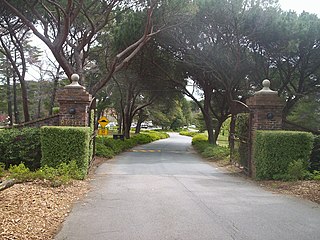
The Canberra Golf Club, later known as the Royal Canberra Golf Club, was formed in 1926. Its original grounds were behind the Hotel Canberra on the river flats on both sides of the Molonglo River.

Stewartby is a model village and civil parish in Bedfordshire, originally built for the workers of the London Brick Company. The village was designed and built to the plans of the company's architect Mr F W Walker, laid out on ‘Garden City’ principle, a later and more modern development than such better-known Victorian model villages as Saltaire. Started in 1926, Stewartby also is a later model than Woodlands which was first planned in 1905. The later retirement bungalow development of the 1950s and 1960s with the pavilion community centre in their midst was designed by the neo-Georgian architect Professor Sir Albert Richardson. Today, Stewartby parish also includes Kempston Hardwick.

Sydney Park is a 41.6-hectare (103-acre) recreational area in the inner-city area of Sydney, New South Wales, Australia. The parkland is located at St Peters, New South Wales], sitting along the borders of Alexandria, Newtown and Erskineville.

The Embassy of Finland to the Commonwealth of Australia is Finland's diplomatic mission in Canberra, Australia. The mission is also accredited to New Zealand, Fiji, Papua New Guinea, Samoa, Tonga, Vanuatu and the Solomon Islands. As it is the only Finnish Embassy in the Southern Pacific region (Oceania) in practice the Embassy also represents Finland in its relations with other Pacific island states in the region.

The Hoffmann kiln is a series of batch process kilns. Hoffmann kilns are the most common kiln used in production of bricks and some other ceramic products. Patented by German Friedrich Hoffmann for brickmaking in 1858, it was later used for lime-burning, and was known as the Hoffmann continuous kiln.

Brickworks is Australia's largest brick manufacturer.

Up Nately is a small village in Hampshire, England, located to the south east of Basingstoke. Its nearest railway station is in Hook, three miles to the east of the village. The Basingstoke Canal runs through the village from the former Penny Bridge in the west, under Brick Kiln Bridge, Slades Bridge and Eastrop Bridge, and, to the east of the village, through the collapsed Greywell Tunnel.

Cocking Lime Works and its associated chalk quarry are abandoned industrial sites in the South Downs of England. They are to the south of the village of Cocking, West Sussex, close to the South Downs Way. The works are on land owned by the Cowdray Estate and are not open to the public. Cocking was the source of lime used for the manufacture of Midhurst White bricks and for agricultural purposes.
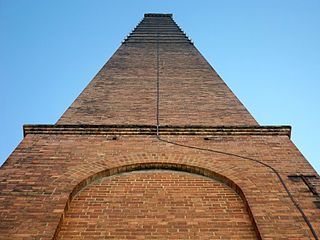
Newmarket Brickworks Chimney is a heritage-listed brickworks at 117 Mina Parade, Alderley, City of Brisbane, Queensland, Australia. It was built in 1912. It is also known as Hoffman Stack. It was added to the Queensland Heritage Register on 24 March 2000.
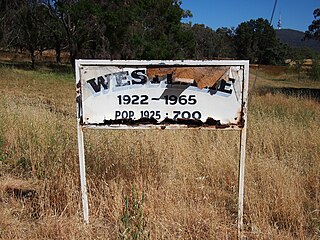
Westlake in Canberra is a ghost town on the outskirts of Yarralumla, Australian Capital Territory. Westlake was a suburb of Canberra from 1922 until 1965. Remnants of constructions and buildings are still visible today.
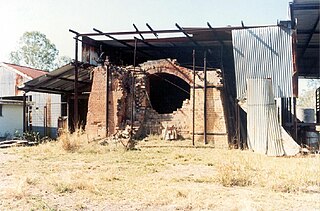
Pindi Pindi Brickworks is a heritage-listed former brickworks off the Bruce Highway, Pindi Pindi, Mackay Region, Queensland, Australia. It was built in 1933. It is also known as Evans Firebricks Ltd and Pindi Pindi Firebricks Company. It was added to the Queensland Heritage Register on 27 October 2000.

Porth Wen Brickworks is a now disused Victorian brickworks which produced fire bricks, made from quartzite (silica) used to line steel-making furnaces. The substantial remains include a number of buildings and the remains of some of the machinery, but has some damage from sea erosion. The site is a scheduled monument.
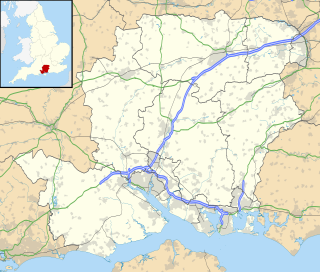
The Brickworks Museum, also known as Bursledon Brickworks, is a volunteer-run museum in Swanwick, Hampshire, England. It is purportedly the UK's sole surviving Victorian steam-driven brickworks.

The Lithgow Valley Colliery and Pottery Site is a heritage-listed former pottery and colliery and now pottery and visitor attraction at Bent Street, Lithgow, City of Lithgow, New South Wales, Australia. It was built from 1876 to 1945. It is also known as Lithgow Pottery and Brickworks. The property is privately owned. It was added to the New South Wales State Heritage Register on 2 April 1999.





















